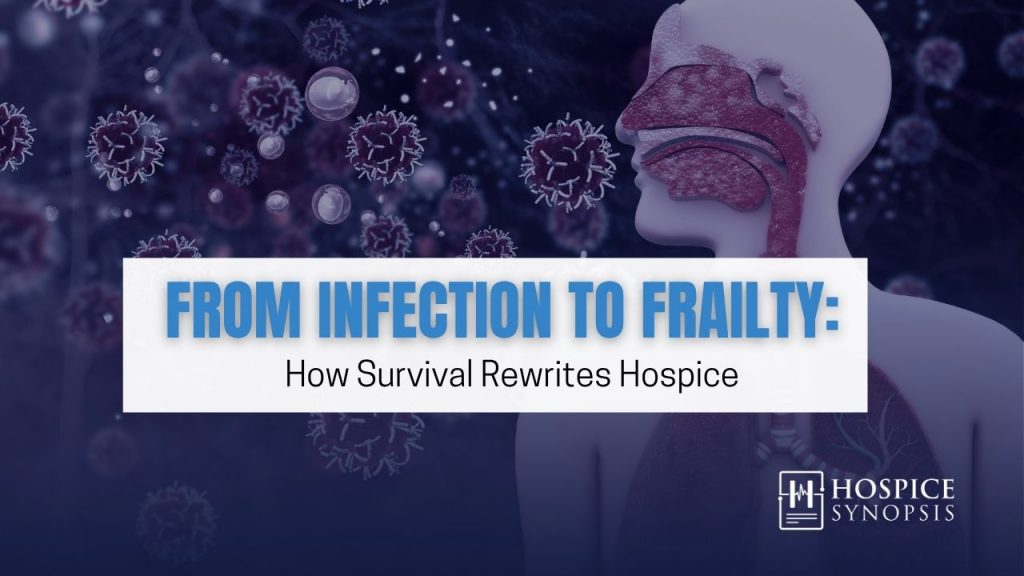What does the last 100 years of dying reveal about hospice eligibility, prognostication, and purpose today?

For most of human history, death came quick. Today, it lingers.
Infections gave way to chronic disease and frailty. CDC and WHO data show ischemic heart disease, stroke, dementia, and multimorbidity now lead deaths in most high-income nations (Centers for Disease Control and Prevention [CDC], 2023; World Health Organization [WHO], 2020).
Survival changed dying. So now, functional decline now defines hospice.
When Dying Was Fast
In 1900, U.S. life expectancy was 47 years. Pneumonia killed over 200 per 100,000. Tuberculosis, diarrheal illness, and childbirth ended lives early. Families knew dying. Doctors stood helpless.
Hospice wasn’t as needed. Death came too fast for meaning.
When Medicine Became the Middle Chapter
Science extended life but left decline in its place.
Antibiotics stopped once-fatal infections. Vaccines reshaped childhood survival. Cardiac cath labs and statins cut heart attack deaths. ICUs pulled patients back.
Myocardial infarction deaths fell 90% from 1970 to 2022. Heart failure deaths rose 146% (Heidenreich et al., 2022). A heart attack may not kill, but it scars, weakens, and leaves decline.
The legacy of survival is frailty.
Death: Slow, Unpredictable, and Costly
The arc of sudden infection is rare. Decline dominates.
Heart failure kills over 130,000 annually. Dementia drives more than one in five hospice admissions (National Hospice and Palliative Care Organization [NHPCO], 2023). Multimorbidity defines enrollment.
Frailty is a progressive loss of strength, endurance, and reserve.
A patient once told me, “I feel like I’m dissolving.” No one can accurately tell you with certainty how long it lasts—or how heavy it gets.
This is the modern end of life: slow, unpredictable, and costly.
How Hospice Entered the Story
Hospice rose from medicine’s victories. It wasn’t built for infection. It steadied decline and focused comfort. See The Shape of Dying for illness trajectories and their impact.
Hospice followed where medicine left patients.
As life expectancy shifts, so does hospice care and expectations.
The Epidemiologic Transition and Early Referral
The shift from infection to chronic illness changed who benefits most from hospice. Patients now live with unpredictable decline and heavy symptom burden, where aggressive treatments add little (Aldridge & Bradley, 2017; CDC, 2023; WHO, 2020).
Medicare requires physicians to certify a prognosis of six months or less. In cancer this is clear. In dementia or frailty, it isn’t. Prognostic tools support judgment. NHPCO recommends referral after repeated hospitalizations, functional loss, or >10% unintentional weight loss in six months (NHPCO, 2023).
Patients most likely to benefit from early referral include:
- Advanced heart failure with refractory symptoms and frequent admissions (Heidenreich et al., 2022; Chuzi et al., 2025)
- Stroke with severe disability (Aldridge & Bradley, 2017)
- Advanced dementia with immobility, minimal speech, incontinence, infections, and weight loss (NHPCO, 2023)
- End-stage frailty with exhaustion, weakness, inactivity, weight loss, and ADL dependence (Aldridge & Bradley, 2017; NHPCO, 2023)
Across all, the strongest predictor is functional loss. See PPS in Hospice for scoring decline.
Early hospice improves pain, dyspnea, anxiety, reduces hospitalizations, and supports families. In advanced heart failure, it may even extend survival (Aldridge & Bradley, 2017; Heidenreich et al., 2022; Chuzi et al., 2025).
Yet clinicians still delay. Many expect cancer-style trajectory of decline. But guidelines call for earlier integration (Cagle et al., 2020). The system must catch up to reality.
Why Hospice Still Misses It
Mr. Henry was 84. He survived a heart attack, then a stroke. Over three years he stopped walking to the mailbox, then stopped remembering lunch, and then another fall. His daughter took FMLA leave twice to bolster care, but the hospice referral still came late. He died 36 days after admission.
This is the habit of medicine from the past. We still look for slow and steady decline.
Data sharpens this point:
- Hospice use: 71% of cancer deaths vs. 45% of non-cancer deaths (Cagle et al., 2020)
- Median length of stay: 14.7 days (NHPCO, 2023)
The six-month rule was written to fit that pattern of a slow steady decline. But this often fails a patient who dies from frailty pattern with periods of plateau.
Immediate Impact
What’s Important Now?
- Document function (PPS, FAST, ADLs). Focus on change in trajectory + the story.
- Teach frailty literacy in IDG so we recognize a pattern before a crisis.
- Forecast decline (Two-Minute Forecast). Define expectations from the family.
If we miss the current shape of dying, patients lose relief, families lose trust, and teams lose defensibility. Delay adds suffering. Missed signals trigger crisis care.
We cannot leave the middle unattended.
Three Takeaways
- Survival reshaped death: from infection to frailty.
- Hospice exists to carry the burden of survival, not just mark the fact of dying.
- Function—decline in mobility, speech, and ADLs—proves eligibility more than diagnosis.
Two Recommendations
- Ask, do I see decline even when the disease looks “stable”?
- Name frailty as terminal and document that decline
One Action Step
At your next IDG, ask: Does our documentation show functional loss, or only the disease name?
“Even if a heart attack does not kill someone, it leaves behind myocardial scarring, remodeling, and vulnerability. The legacy of survival is decline.”
– Brian H. Black, D.O.
Bibliography
Aldridge, M. D., & Bradley, E. H. (2017). Epidemiology and patterns of care at the end of life. Health Affairs, 36(7), 1175–1183. https://doi.org/10.1377/hlthaff.2017.0182
Cagle, J. G., Zimmerman, S., Cohen, L. W., et al. (2020). Hospice utilization in the United States: Cancer versus non-cancer patients. Journal of the American Geriatrics Society, 68(4), 783–793. https://doi.org/10.1111/jgs.16348
Centers for Disease Control and Prevention. (2023). National Vital Statistics Reports: Leading causes of death. CDC WONDER Database. https://wonder.cdc.gov/
Chuzi, S., Givertz, M. M., Goldstein, N. E., et al. (2025). HFSA consensus statement on palliative care integration in advanced heart failure. Journal of Cardiac Failure, 31(3), 559–573. https://doi.org/10.1016/j.cardfail.2025.01.007
Heidenreich, P. A., Bozkurt, B., Aguilar, D., et al. (2022). 2022 AHA/ACC/HFSA guideline for the management of heart failure. Journal of the American College of Cardiology, 79(17), e263–e421. https://doi.org/10.1016/j.jacc.2021.12.012
National Hospice and Palliative Care Organization. (2023). NHPCO facts and figures: Hospice care in America. https://www.nhpco.org/hospice-facts-figures/
World Health Organization. (2020). The top 10 causes of death. https://www.who.int/news-room/fact-sheets/detail/the-top-10-causes-of-death

Leave a Reply